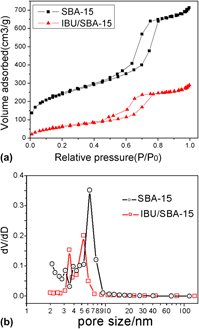Crossref Citations
This article has been cited by the following publications. This list is generated based on data provided by
Crossref.
de Matos, M.B.C.
Piedade, A.P.
Alvarez-Lorenzo, C.
Concheiro, A.
Braga, M.E.M.
and
de Sousa, H.C.
2013.
Dexamethasone-loaded poly(ɛ-caprolactone)/silica nanoparticles composites prepared by supercritical CO2 foaming/mixing and deposition.
International Journal of Pharmaceutics,
Vol. 456,
Issue. 2,
p.
269.
Gignone, Andrea
Manna, Luigi
Ronchetti, Silvia
Banchero, Mauro
and
Onida, Barbara
2014.
Incorporation of clotrimazole in Ordered Mesoporous Silica by supercritical CO2.
Microporous and Mesoporous Materials,
Vol. 200,
Issue. ,
p.
291.
Gignone, Andrea
Delle Piane, Massimo
Corno, Marta
Ugliengo, Piero
and
Onida, Barbara
2015.
Simulation and Experiment Reveal a Complex Scenario for the Adsorption of an Antifungal Drug in Ordered Mesoporous Silica.
The Journal of Physical Chemistry C,
Vol. 119,
Issue. 23,
p.
13068.
Ibrahim, Abdul-Rauf
Li, Xiangyun
Zhou, Yulan
Huang, Yan
Chen, Wenwen
Wang, Hongtao
and
Li, Jun
2015.
Synthesis of Spongy-Like Mesoporous Hydroxyapatite from Raw Waste Eggshells for Enhanced Dissolution of Ibuprofen Loaded via Supercritical CO2.
International Journal of Molecular Sciences,
Vol. 16,
Issue. 4,
p.
7960.
Restani, Rita B.
Silva, A. Sofia
Pires, Rita F.
Cabral, Renato
Correia, Ilídio J.
Casimiro, Teresa
Bonifácio, Vasco D. B.
and
Aguiar-Ricardo, Ana
2016.
Nano-in-Micro POxylated Polyurea Dendrimers and Chitosan Dry Powder Formulations for Pulmonary Delivery.
Particle & Particle Systems Characterization,
Vol. 33,
Issue. 11,
p.
851.
Tkalec, Gabrijela
Knez, Željko
and
Novak, Zoran
2016.
PH sensitive mesoporous materials for immediate or controlled release of NSAID.
Microporous and Mesoporous Materials,
Vol. 224,
Issue. ,
p.
190.
Shen, Shou-Cang
Dong, Yuan-Cai
Letchmanan, Kumaran
and
Ng, Wai Kiong
2017.
Nanostructures for Oral Medicine.
p.
699.
Tanaka, Magali Naomi
Santos, Solange Teixeira Soares
Gouveia, Marize
dos Santos Filho, Mery
Cosentino, Ivana Conte
Neto, Jair Borges Barbosa
Tufik, Sergio
do Rosário Matos, Jivaldo
and
Mercuri, Lucildes Pita
2017.
Encapsulation study of citalopram and risperidone into nanostructured silica SBA-15 for in vitro release evaluation.
Journal of Thermal Analysis and Calorimetry,
Vol. 127,
Issue. 2,
p.
1725.
Reiser, Sarah
Sun, Miaotian
Johannsen, Monika
and
Türk, Michael
2018.
Influence of chemical nature of carrier materials on the dissolution behavior of racemic ibuprofen.
The Journal of Supercritical Fluids,
Vol. 132,
Issue. ,
p.
91.
Reiser, Sarah
Shaban, Masoom
Weber, Alfred
and
Türk, Michael
2018.
CO2 assisted deposition of R/S-ibuprofen on different porous carrier materials: Influence of carrier properties on loading and dissolution behavior.
Journal of CO2 Utilization,
Vol. 25,
Issue. ,
p.
216.
Reiser, Sarah
and
Türk, Michael
2019.
Influence of temperature and high-pressure on the adsorption behavior of scCO2 on MCM-41 and SBA-15.
The Journal of Supercritical Fluids,
Vol. 144,
Issue. ,
p.
122.
Banchero, Mauro
Mohamed, Sara S. Y.
Leone, Federica
Lopez, Francesca
Ronchetti, Silvia
Manna, Luigi
and
Onida, Barbara
2019.
Supercritical Solvent Impregnation of Different Drugs in Mesoporous Nanostructured ZnO.
Pharmaceutics,
Vol. 11,
Issue. 7,
p.
340.
Johnson, Kelli-anne
Muzzin, Nicola
Toufanian, Samaneh
Slick, Rebecca A.
Lawlor, Michael W.
Seifried, Bernhard
Moquin, Paul
Latulippe, David
and
Hoare, Todd
2020.
Drug-impregnated, pressurized gas expanded liquid-processed alginate hydrogel scaffolds for accelerated burn wound healing.
Acta Biomaterialia,
Vol. 112,
Issue. ,
p.
101.
Othman, Amr M.
Ghobashy, Mohamed Mohamady
and
Abd El‐Sattar, Nour E. A.
2021.
Radiation synthesis of porous calcium silicate aerogel derived from polyacrylamide hydrogel as thermal insulator.
Journal of Sol-Gel Science and Technology,
Vol. 98,
Issue. 3,
p.
593.
González, Juan
Pérez, Eduardo
Pepczynska, Marzena
Calvo, Lourdes
and
Cabañas, Albertina
2023.
Supercritical Solution Impregnation of naproxen into mesoporous SiO2 SBA-15.
Journal of CO2 Utilization,
Vol. 73,
Issue. ,
p.
102518.
Grini, Mohammed Ilyes
Benbayer, Chahinez
Saidi-Besbes, Salima
and
Elaissari, Abdelhamid
2025.
Advances in mesoporous silica nanoparticles as carriers for drug delivery and other biomedical applications.
Microporous and Mesoporous Materials,
Vol. 391,
Issue. ,
p.
113603.



